Ross Sea
deep sea of the Southern Ocean in Antarctica
The Ross Sea in Antarctica is the world's most southerly sea. It's ice-bound for much of the year, but at the height of summer ships can cautiously enter. It's therefore long been a focus of polar exploration, especially towards the South Pole. Cruise liners from Australia and New Zealand routinely visit, whilst those sailing from the tip of Argentina tour the Antarctic Peninsula on the opposite side of the continent.
Ross Island in the southwest corner of that sea is 30 km from the mainland and is permanently welded to it by sheet ice. It's rugged and actively volcanic, with exposed rock that you can build on. There have been exploration camps here for over a century, still preserved, and permanent bases since 1956.
McMurdo Station is a US base on Ross Island. Nearby is New Zealand's Scott Base, with Antarctica's first bus service shuttling between them. Over 1000 people work here in summer and 100 in winter. It has airfields and wharfs for shipping, so it's a support and transport hub for the South Pole and other bases in Antarctica.
Understand
| Ross Sea | ||||||||||||||||||||||||||||||||||||||||||||||||||||||||||||
|---|---|---|---|---|---|---|---|---|---|---|---|---|---|---|---|---|---|---|---|---|---|---|---|---|---|---|---|---|---|---|---|---|---|---|---|---|---|---|---|---|---|---|---|---|---|---|---|---|---|---|---|---|---|---|---|---|---|---|---|---|
| Climate chart (explanation) | ||||||||||||||||||||||||||||||||||||||||||||||||||||||||||||
| ||||||||||||||||||||||||||||||||||||||||||||||||||||||||||||
| ||||||||||||||||||||||||||||||||||||||||||||||||||||||||||||
Early explorers into Antarctic waters encountered a vast barrier of ice. They could hardly tell what was mainland, what was islands, or what was just sea-ice. But from the 19th century they found more areas accessible in summer, such as the Peninsula. In the Ross Sea they found an inlet that was much further south yet occasionally navigable, with potential access to the interior. Better still, Ross Island had a natural harbour, and bare rock that was much safer to build huts on than the shifting, cracking ice. The island became the springboard for journeys into the interior. There wasn't much whaling or sealing activity here as these creatures depend on open water and dwell further north.
In the 19th and 20th century several nations staked claims to Antarctica, and New Zealand claimed the "Ross Dependency", a pie-segment of the continent from the pole to the Ross Sea. However this was superseded in 1959 by the Antarctic Treaty, which seeks to protect the fragile environment and sets aside national claims. Thus, various nations own and operate bases here and have hypothetical claims to territory which they waive. References to nations on this page should be understood accordingly. The treaty forbids military activity but there is no objection to military logistics support to civilian work: nothing could get done here without their heavy-duty aircraft.
Get in
By plane
Flights to McMurdo start from Christchurch, New Zealand, and take 8 hours in military cargo planes such as the Lockheed C-130 Hercules. McMurdo has three airstrips, which act as staging posts for flights further into the continent.
- Williams Field is a pair of groomed snow runways on the ice sheet 15 km south of Ross Island, for ski-planes only, operating Dec-Feb. The surface is 8 m of compacted snow, lying on top of 3 m of ice floating over the sea channel. "Willy Field" (as it's known) is gradually drifting towards the calving edge of the ice but the facilities are mounted on sleds, and have been moved three times. A 16-km pipe snakes across the ice to bring aviation fuel from McMurdo. Pilots will know that Williams himself was lost in 1956 when the ice gave way beneath his tractor.
- The Ice Runway is a pair rebuilt each spring and is the principal airfield in early summer, as it can take conventional wheeled aircraft, which have greater range and capacity than ski-planes. A Boeing 757 has test-landed here, and it's hoped to use 757s for passenger flights, freeing cargo space on other flights. The runway is 21 km south of the island. Planes at rest tend to sink into the ice, and are towed elsewhere if this becomes marked. By mid-Dec the ice begins to break up, the runway is abandoned and operations switch to Williams Field.
- Phoenix Airfield opened in 2017 and is 21 km from McMurdo. Ift is a single runway of compressed snow that is firm enough to take wheeled aircraft. It was planned to be firm enough to use all summer, but has proved to be only suitable early in the season. So it has duplicated the Ice Runway without extending the season in which wheeled aircraft can come into McMurdo. It replaced nearby Pegasus Airfield, which was plagued by dust and has closed.
By boat
See Antarctica for cruises departing from Australia or New Zealand that sail this way.
Once or twice a year, an icebreaker forces its way into 🌍 Winter Quarters Bay, with a freighter and an oil tanker in its wake. They hurriedly unload and depart, so if you arrive by these means it's either a short stay or a long one. The bay is the world's southernmost harbour, named by Scott as his 1901-1904 Discovery expedition spent two winters here. They'd only intended a single winter, but were unable to free their ship from the ice in summer 1902/03, and again for much of summer 1903/04. With a third winter almost upon them they were about to abandon ship, when the ice loosened and they were able to blast their way out to sea.
Early unloading was either onto the ice shelf — hazardous and slow — or onto a metal pier, which the winter seas quickly demolished. The bay now uses an ice pier. This is a container of some 240 x 90 m flooded with sea-water that freezes, topped by gravel to form a driving surface, and secured in place by hawsers. After 3-5 years it needs replacing, and the old one is towed away and left to drift and melt, with a beacon to warn off shipping until it sinks.
Beneath the bay is a ridge which keeps icebergs away, but traps pollution. The ice here was long used as the island's refuse tip, so every spring it melted and the trash went out-of-sight, out-of-mind. A 2001 survey revealed 15 vehicles, 26 shipping containers, 603 fuel drums and much else down there. There were also bilge-oil discharges from docked ships, and run-off from dumping sites on land. The station's eco-rhetoric will ring hollow until this is remedied.
Get around
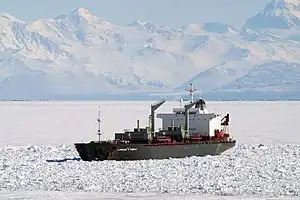
The dog-sleds finally retired in 1986 so transport close to the bases is on foot, skis, snowmobiles, bus or tractors, while helicopters and light ski-aircraft venture further out. The road between McMurdo and Ross bases is a firm dirt track. Snow tracks cross the ice to the airfields and onto the mainland, climbing into the mountainous interior.
🌍 McMurdo Bus Station is the Downtown terminus of Ivan the Terra Bus, a chunky red six-wheeler with 56 seats and a big baggage trunk. It runs whenever needed to the harbour, Scott Base and out to the airstrips to meet the flights.
Never venture anywhere outside by any method without checking with your hosts whether your intentions are sensible; and let them know when you've arrived or returned safely. Conditions can turn from sparkling daylight to howling blizzard in an instant. The wind whips up the snow into a white-out where you have no sense of where you're going, and you must be able to navigate by instrument. There are refuge huts dotted about the island.
See and do
Around the bases
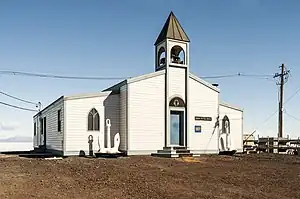
- McMurdo Station covers the tip of the southern peninsula of Ross Island, including the site of the NZ Scott Base. It is bare rock, and next to a natural harbour, so the earliest explorers spotted its potential, and both the US and NZ stations were founded here in 1957. The residential area around the bus station is called "Downtown". The US station has some 1250 staff in summer and 250 in winter.
- 🌍 Chapel of the Snows (Downtown). This non-denominational Christian church opened in 1989, replacing earlier buildings which burned down. It also hosts meetings of other faith groups and non-religious assemblies; in 2019 it was due for replacement (along with much of McMurdo), but COVID-19 has held that up. The altar is believed to come from St Saviour's in Lyttelton New Zealand, the last place Captain Scott attended church before sailing south. The Erebus Chalice of silver and gold was thought to come from HMS Erebus which mapped the Ross Sea around 1840, but it's now known to have been made in London in 1910. (updated Dec 2022)
- 🌍 Albert P. Crary Science and Engineering Center (Crary Lab). Opened in 1991, this is the main scientific and technical working area within the station. It consists of five pods with a two-storey core, a biology pod, earth sciences and atmospheric sciences pods, and an aquarium. (updated Feb 2020)
- 🌍 Observation Hill. The 230-m lava plug that rears up just north of the station and gives good views of the area. Halfway up, there's a bronze plaque near the site of the nuclear power plant that served the base 1962-72; it began cracking and leaking so it was replaced by diesel generators. At the summit, a wooden cross commemorates Scott, Oates, Bowers, Wilson and Evans, who perished in March 1912 on their return from the South Pole. They'd reached the Ross Ice Shelf and were within 20 km of a supply dump and close to rendezvous with their ship Terra Nova, but in failing health and weather they couldn't go further. The ship over-wintered and next spring sent out a search party which located them. Their notebooks and scientific samples were recovered (the first to prove that Antarctica once had a warm climate) then the tent was collapsed to become their grave. It became lost beneath deep snow and is now reckoned to lie 30 m deep within the ice shelf that you see from the hill. The ship's crew erected the cross before sailing home. (updated Apr 2022)
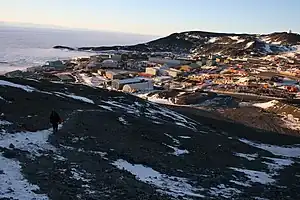
- 🌍 Discovery Hut near the harbour was built by Scott on his Discovery expedition of 1902. It proved too cold and draughty for living quarters, so the crew just used it for storage while sleeping on the ship or in tents. The nearby cross is for George Vince, lost in a fall on that expedition. Later expeditions made similar use of the hut then it was abandoned from 1917. In 1956 it was dug out of the snow and is now preserved as a historic building. Don't refer to it as "Scott's Hut" as that's out of town and was built for his later expedition to avoid living here.
- 🌍 Scott Base, ☏ +64 3 358 0200. The New Zealand base is 3 km from McMurdo, standing on firm rock at Pram Point. There's been a base here since 1957 but only the mess hut remains of the original buildings. It's a series of modules linked by covered corridors, staffed in summer by 85 and in winter by ten. (updated Feb 2020)
- Play disc golf: this is the version where you stand on a tee and flip a disc towards a distant target basket, playing your disc from wherever it lands. It's a nine-hole course, set up each spring along a varying Downtown route. There are no tee-pads, so you may be flipping from an inclined icy surface, in the teeth of savage winds, while dodging moving machinery. Call at the recreation centre for discs, a map of the current course and club rules. There are no plans for a conventional golf course but, considering some of the strange places the game has been played, this is surely only awaiting a creative course designer.
Rest of Ross Island
- 🌍 Scott's Hut is on Cape Evans, on the west of Ross Island. It was built as a pre-fab by Scott in 1911 on his Terra Nova expedition to be more comfortable accommodation than his earlier "Discovery Hut". Indeed it was sometimes stiflingly hot. There were working areas and a stable for the ponies to draw the sleds. The nearby cross is for members of the "Ross Party" supporting Shackleton's 1914-17 attempt to cross the continent. They were laying supplies ahead of the main party, but their ship was torn from its moorings and they were marooned here.
- 🌍 Shackleton's Hut is at Cape Royds, the westernmost point of the island. He built this place 40 km north of Scott's Hut as a base for his 1907-09 Nimrod expedition. Many supplies were left behind, with a welcome note for anyone to use them, but only in 2006 was their stash of whisky and brandy discovered beneath the hut. The whisky has been recreated and sold as "Mackinlay's Shackleton Blended Malt". Off Cape Royds is a polynya: an area of open sea, where strong winds keep the ice away. This is crucial for penguins, and there's an Adélie penguin colony here, well south of their usual range.
.jpg.webp)
- 🌍 Mount Erebus is 35 km north of McMurdo in the centre of Ross Island. It's 3795 m high and is the world's southernmost active volcano. It's a Stromboli-type volcano, erupting continuously but without great violence, so it can be approached closely for study and for climbing. The usual climbing routes are from Lake Wilson on its western flank. It was discovered in 1841 by Ross (who gives his name to the Ross Sea), who named it and nearby Mount Terror after his two expedition ships HMS Erebus and HMS Terror. These ships were built as bombardiers, designed to fire mortars, so the names were apt. (The ships were later lost in Franklin's disastrous 1845 expedition to find the Arctic Northwest passage; their wrecks were only found in 2014 and 2016.) The summit crater of Erebus is a lava lake, fed from below by a magma chamber. Steam from side fumaroles freezes to create ice chimneys where microbial life is self-sustaining, with no sunlight or external organic input, so they may model life-processes on the early Earth or on other planets. The first people to climb Erebus were in Shackleton's 1908 expedition, and there are historic, protected campsite remains from Scott's 1912 expedition. (That party showed what they thought of it by naming one feature "Nausea Knob".) A modern observation station is run by the University of New Mexico but operates remotely. On 28 Nov 1979 Erebus was the scene of the Air New Zealand Flight 901 disaster, killing all 257 people on board. There was a navigational error and, although visibility was good, the pilots failed to see the white-against-white of the mountain ahead of them. The wreckage is still visible in summer on the north flank.
- 🌍 Mount Terror is an extinct shield volcano on Ross Island 30 km east of Erebus. It's 3262 m (10,702 ft) high but less prominent than Erebus, as it rises among other hills. Don't confuse it with Mount Terror in Washington State USA, or you'll get entirely the wrong climbing instructions.
- A ridge connects Erebus and Terror, with Mount Terra Nova the intermediate peak of 2130 m (6990 ft).
- Mount Bird is the extinct shield volcano that forms the north part of Ross Island. It's 1765 m (5791 ft) high.
- Mount Discovery is the fourth volcano of this cluster, an extinct stratovolcano of 2681 m (8796 ft). It's on the mainland, separated from Ross Island by McMurdo Sound, but since that's usually frozen solid the distinction may not be obvious.
Further out
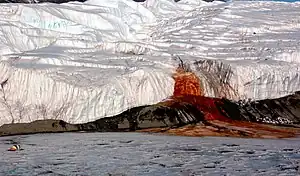
- Other islands of the Ross Archipelago are seldom visited, which means their habitat is almost undisturbed. They are:
- Beaufort Island 21 km north is the stump of an ancient stratovolcano. It has sheltered areas with colonies of Emperor and Adélie penguins and south polar skua. It even has patches of mossy vegetation.
- Dellbridge Islands are a group of four islets south of Ross Island, named Inaccessible, Tent, Big Razorback and Little Razorback islands.
- White Island is 28 km long and snow-clad. It has a colony of Weddell seals.
- Black Island just west of it is mostly ice-free. There's a radio mast and a remotely-operated outstation of McMurdo.
- 🌍 Blood Falls are a lurid red flow out of the foot of Taylor Glacier. They stem from a pocket of sea cut off some 2 million years ago, overlain by the glacier and hypersaline so it doesn't freeze. The pocket is devoid of oxygen and contains strange micro-organisms plus iron ores - the iron oxidises on contact with the atmosphere to make the outflow rust-coloured.
- Victoria Land is the Ross Sea western shore and hinterland merging into Eastern Antarctica. It's notable for "dry valleys" with very low snow and rainfall, and small lakes and ponds that are too saline to freeze. Its glaciers have gathered up meteorites falling on the interior, one of which is believed to be of lunar origin, and another Martian, plus - the icing on the cake - a fruitcake. This was lost by Captain Scott's party and was still in good condition.
- 🌍 Zucchelli Station is a seasonal Italian base in Victoria Land. They have an ice airfield but climate change is shortening the season when this can be used, so in 2022 they're building a gravel runway on the glacier moraine to take long-distance wheeled aircraft.
- Jan Bogo is a South Korean base 5 km north of Zucchelli. Also in Victoria Land is Gondwana (Germany); the NZ Vanda base has closed. There are no bases along the Ross Sea east coast bordering Marie Byrd Land.
_(NSF).jpg.webp)
- 🌍 Transantarctic Mountains hug the west coast of Ross Sea, and as the name implies, they stretch right across the continent, becoming indistinct on the western plateau then re-emerging to form the Peninsula. Mount Kirkpatrick (marked on map) at 4528 m (14,856 ft) is the highest of this range and can be climbed. It's mostly ice-free because of the dry climate and scouring winds, revealing its fossil sediments.
- Mainland glaciers flowing into the Ross Sea are what you must slog up to reach the Antarctic plateau and eventually the pole overland. Largest is the Beardmore Glacier, 40 km wide, and this was the route taken by Scott in 1911/12. But Amundsen reached the pole a month earlier, finding a shorter route through the mountains via the Axel Heiberg Glacier. From McMurdo to the pole is some 1360 km; the bus will only take you 20 km of that but every little helps.
- South Pole Traverse is a 1600-km trail from McMurdo Station to the South Pole. It's compacted snow with crevasses filled in and marked by flags. It can only be traveled by specialized tractors, hauling sleds with fuel and supplies. These aren't very nimble so the trail takes a long swerve around the Transantarctic Mountains to come onto the plateau. Ski treks from coast to Pole are partly along this route, but take short-cuts through the mountains to bring the distance below 1200 km. They're extremely expensive, take about two months, and demand high levels of fitness and endurance. They're one-way treks and you fly back. No one has yet marketed the reverse trek from Pole to McMurdo, but presumably for enough money a bespoke trip could be arranged.
- Giant icebergs the size of counties calve from the glaciers. B-15 from 2000 was the size of Jamaica ("B" indicates an origin in this quadrant of the continent), and as late as Dec 2022 one city-sized fragment persisted. They're satellite-tracked, but only a concern if they get free of the ice pack into open water: see Subantarctic Islands for icebergs that are in this category.
Buy
- Berg Field Center (south side of Downtown). Outdoor suppliers to kit you out with whatever you need to stay alive here. (updated Feb 2020)
Eat and drink
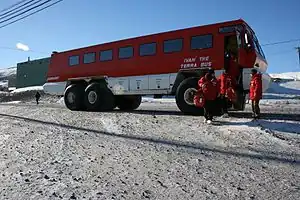
Food is a big deal anywhere in Antarctica; good food makes happy people, and people living and working in Antarctica have big appetites. As with other bases in Antarctica, most food is frozen or preserved and arrives just once a year by cargo ship. For around two months in early summer, "freshies" (fresh fruits and vegetables) arrive on weekly planes from New Zealand; this tails off by January as priority is given to cargo and passengers. A variety of excellent fresh breads and baked sweets are always available. Pizza is quite popular, and is often used as a "McMurdo garnish": adding a slice of delicious fresh pizza on top of your already-full plate of food!
The main place you'll eat at is the Galley, Building 155. 24/7. The galley serves cafeteria-style meals for everyone on base, and visitors with prior permission. Breakfast, lunch, and dinner are two hours each, and during the busy summer months an extra midnight meal is added with priority going to those working night shifts. Most meals offer 5 or 6 main courses, and a wide assortment of sides and desserts. Outside of regular mealtimes, snacks, leftovers, and fresh pizza are available at any time. Free (but only take what you will eat, and eat everything you take).
Other places for a bite or drink are:
- Gallaghers Pub / Southern Exposure. Tu-Sa 7–11PM, Su 6–10PM.
- McMurdo Coffee House. Daily 7–11:30PM.
- McMurdo Station Pizza, ☏ 2455 (domestic). 10AM–10PM. Closed Thanksgiving and Christmas. Craving some pies for your labmates, or maybe just one for yourself? Call up and custom order exactly what you want. Free.
- Amaza Cafe (near Scott Base). They spin a good tale about how the polar Coriolis Force boosts their coffee flavour.
Gluten-free, vegetarian, and vegan menu items are often available. If you have food allergies or other dietary restrictions, be prepared for limited choices.
Sleep
This is no place for wild camping. Your trip organizer must either negotiate access to the base or bring a large self-sufficient expedition.
Cope
- Building 155 Downtown has Wells Fargo ATMs and a library. The Station canteen is here but visitors can only use it by prior permission.
- The hospital is one block east of Building 155.
- The US Post Office is at the top of town at the start of the road to Scott Base.
- The Antarctic Sun is an online magazine about the US Antarctic Program.
Go next
- Cruises to the Ross Sea from Australia and New Zealand may tour the coast of East Antarctica as far as Commonwealth Bay before returning north. They may also take in subantarctic Macquarie Island.
- The South Pole could be your next stop, as its flights are via McMurdo.
Wikivoyage: Latitude -77.850, Longitude 166.667 (Map, Geohack)
Wikidata: Latitude -75, Longitude -175 (Map, Geohack)
Difference: 569.0km